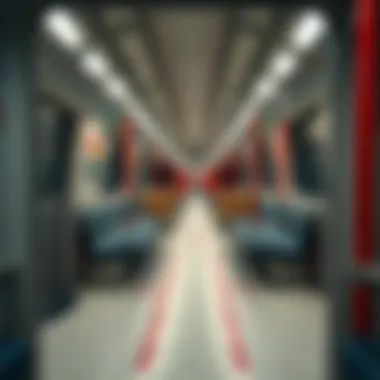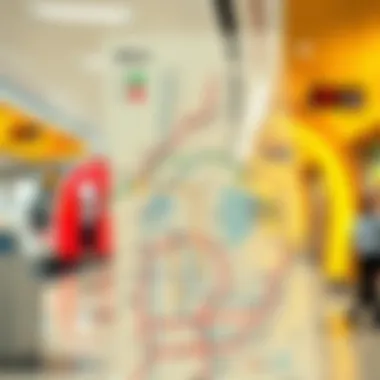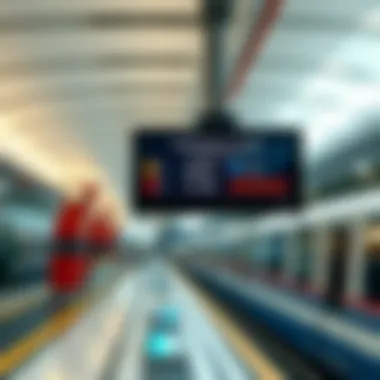Dubai Metro Timing Today: A Complete Overview


Intro
Navigating the bustling city of Dubai can seem daunting, especially for those new to the area. With its sprawling metro network, the Dubai Metro offers a reliable and efficient way to travel across this vibrant metropolis. This guide sheds light on the essential timings of the Metro, including key operating hours for weekdays and weekends, peak hours, as well as valuable tips for making the most of the transit system.
Whether you’re a resident commuting to work or a visitor exploring the city’s attractions, understanding the Metro's schedules is crucial. For example, if you're planning to visit the Burj Khalifa or the Dubai Mall, knowing when to hop on and off the Metro will save you a lot of time and stress. Here's what you need to know about Dubai’s Metro timing today.
Market Analysis
The Dubai Metro has become more than just a transportation solution; it has also influenced various sectors, especially real estate and tourism. With an increasing number of projects sprouting around metro stations, the value of properties near these lines tends to rise significantly.
Current Trends in Property Prices
As of late 2023, property prices in proximity to Dubai Metro stations are on the rise. Many developers are capitalizing on this trend by investing in properties that offer easy access to the Metro. Areas such as Dubai Marina and Downtown Dubai, which are well-served by the Metro, have seen a steady increase in demand. This surge can be attributed to the convenience the Metro provides to residents and businesses alike.
- Investors are particularly focused on:
- Properties within a 10-minute walk from Metro stations.
- Residential units that cater to expatriates and locals working in the city center.
Future Growth Projections
Looking ahead, the Dubai Metro is expected to expand, with additional lines and stations planned. This expansion will likely stimulate further growth in both property values and rental prices around new stations. Experts suggest that areas currently underserved by public transit will experience a boon as access to the Metro increases. The UAE government is also keen on promoting public transport use, making it a focal point in their urban development strategies.
"The expansion of the Metro signifies not just progress in transportation, but also in real estate values across Dubai," notes a local real estate analyst.
Buying and Selling Tips
For those interested in capitalizing on the shifting metro-enhanced landscapes, understanding the market is key. Here’s how to approach buying or selling properties effectively associated with the Metro.
Essential Steps for First-Time Buyers
- Research the Area: Investigate properties around the nearest Metro stations to assess your options.
- Consult Real Estate Experts: Work with agents who specialize in transit-oriented developments.
- Consider Future Prospects: Look for neighborhoods that are slated for upcoming metro expansions, as they offer substantial long-term value.
Strategies for Selling Properties Effectively
- Highlight Accessibility: Ensure your listing emphasizes proximity to the Metro and its benefits.
- Leverage Market Trends: Pull in potential buyers by showcasing local demand, leveraging data on property value increases linked to metro access.
- Use Professional Photos: Capture the allure of your property while including visuals of nearby metro stations, projecting an image of convenience and accessibility.
Overview of the Dubai Metro System
The Dubai Metro stands as a compelling example of modern urban transport initiatives, providing residents and visitors with a reliable means to navigate the bustling city. This system is not merely an infrastructural asset; it epitomizes the progressiveness of Dubai’s urban planning strategy, affecting everything from real estate trends to daily commuting habits.
Historical Context
Inaugurated in September 2009, Dubai Metro was designed to alleviate traffic woes that have long plagued the city's roadways. The project was spearheaded by the Roads and Transport Authority (RTA) with a vision to revolutionize public transit in a city where reliability is key. Over the years, the Metro has expanded significantly, initially consisting of only two lines, Gold and Red. These lines now boast a length of over 75 kilometers, incorporating several high-frequency stations. The Metro was a part of a larger initiative aimed at making the city more accessible and environmentally-friendly.
Current Network and Lines
Today, the Dubai Metro features two primary lines: the Red Line and the Green Line, which connect various key districts such as Dubai Marina, Deira, and the burgeoning Downtown area. The Red Line runs diagonally across the city, providing easy access to major points of interest, while the Green Line intersects it, covering areas often overlooked in traditional transit maps. Both lines are integrated with feeder buses and taxis, allowing for seamless transfers and making it easier to reach locations off the beaten path. The Metro is more than just a train service; it is a lifeline that underscores Dubai's commitment to enhancing urban mobility.
Significance to Urban Mobility
The Metro's significance extends beyond mere transportation; it plays a pivotal role in shaping social and economic landscapes. For residents, it offers reliability and convenience, enabling them to commute to work or leisure activities without the frustration of traffic congestion. For businesses, proximity to Metro stations can be a game-changer, enhancing property value and foot traffic. Furthermore, it contributes to environmental sustainability by reducing the carbon footprint associated with road vehicles. In essence, the Dubai Metro is not just a method of travel; it embodies a sustainable future for urban living, advocating for both efficiency and eco-friendliness.
"The Dubai Metro is a testament to how innovation shapes our lives. It's about more than getting from point A to point B—it's about building a city that works seamlessly for everyone."
In summary, the Dubai Metro system is an essential component of the metropolis's infrastructure, shaping the manner in which the city weaves itself around its inhabitants. Understanding this system's context not only informs daily travel but also offers insights into Dubai's broader socio-economic progression.
Metro Timing Overview


The operational hours of the Dubai Metro are more than just numbers on a timetable; they embody the rhythm of urban life in one of the world’s most vibrant cities. Understanding these timings is crucial for anyone navigating the extensive network of the Metro system, be it residents or tourists. A thorough grasp of when the trains run can significantly affect one’s ability to plan effectively, ultimately making the experience very enriching.
When formulating a plan to explore Dubai, knowing the Metro timings is a game changer. It allows users to avoid peak congestion, ensuring a smoother ride and helping one to reach destinations promptly. Moreover, different schedules apply to weekdays, weekends, and holidays, reflecting the city’s dynamic character. Thus, assessing these timings is fundamentally important for smooth commuting.
In essence, this section pulls together the various operational hours under one umbrella. It’s aimed at ensuring readers can seamlessly coordinate their travel plans with Metro availability, making the journey not only enjoyable but efficient. With such detailed insights, commuters can dodge rush hour scrambles, making way for a more relaxed experience.
Weekday Operating Hours
During the weekdays, the Dubai Metro runs like a well-oiled machine. For those who need to hustle off to work or appointments, knowing the exact starting and ending times can save a good deal of stress. Generally, the Metro operates from 5:00 AM to midnight on weekdays, with trains arriving at intervals of about 7 minutes during peak times, ensuring that commuters don't have to wait too long.
Given that many companies open their doors around 9:00 AM, one can expect the morning rush to begin around 7:00 AM. So, if you can avoid those hours, life just might be easier. To give a clearer picture, these are the usual operating hours:
- 5:00 AM: Metro opens its doors.
- Peak hours (7:00 AM - 9:00 AM): Most frequent service.
- Midday: Slightly reduced frequency.
- 11:00 PM: Last trains leave the stations.
Planning your commute wisely on weekdays can lead to a less frenetic experience.
Weekend Operating Hours
Weekends are a different ball game entirely in Dubai. Friday and Saturday are the official weekend days, and the Metro tailors its schedule accordingly. You can catch the Metro from 10:00 AM to 1:00 AM on Friday, which aligns with the later start many enjoy after the workweek. Saturday's schedule returns to something resembling the weekday routine, operating from 6:00 AM to 1:00 AM.
For instance:
- Friday:
- Saturday:
- 10:00 AM - 1:00 AM (ideal for leisure seekers).
- 6:00 AM - 1:00 AM (back to routine).
These adjustments in weekend hours make the Metro a favorable option for those looking to explore the city’s nightlife or tourist attractions. However, it remains wise to double-check for any fluctuations in timings, especially during holiday seasons.
Holiday Schedules
Navigating the Metro during holidays can pose its own set of challenges. Public holiday schedules often vary significantly from regular weekdays and weekends. Understanding these changes is crucial if you're planning to travel during festive seasons or special events in the UAE. Generally, on public holidays, the Metro system tends to extend its operating hours but it's wise to look into specific dates and events, as timing can fluctuate based on demand and city-wide celebrations.
To sum it up:
- Holidays: Often feature extended hours, but check official sources for specifics.
- Special Events: Large gatherings or festivals can also influence metro operations, making it a hefty task to predict exact timings.
Factors Affecting Metro Timing
Understanding the factors that influence metro timings is crucial for ensuring a smooth transit experience in Dubai. Comprehending these elements not only enhances individual travel efficiency but also sheds light on the larger operational dynamics of the system. Factors such as peak hours, maintenance schedules, and special events can dramatically alter the expected commuting time, urging passengers to plan their journeys thoughtfully. In a bustling city like Dubai, where both residents and visitors rely on the metro for efficient mobility, knowledge in this area can lead to better experiences and time management.
Peak Hours and Demand
Peak hours represent periods of heightened demand where the metro is bustling with commuters. Generally, these hours occur during the morning and evening rush. Specifically, from 7:00 AM to 9:00 AM and from 5:00 PM to 7:00 PM, one can expect crowded trains and longer waiting times. This surge in demand can be attributed to several factors:
- Work Commutes: A significant number of workers utilize the metro to reach their places of employment.
- Tourism: The influx of tourists visiting major attractions adds to the demand during key hours.
Traveling during these peak times can lead to a less comfortable journey. Therefore, it's advisable to strategize and possibly schedule travel outside these busy intervals if solitude is desired. Utilization of applications offering real-time updates can also contribute to better planning.
Maintenance and Updates
Regular maintenance is essential to ensure safety and reliability within the metro system. Scheduled upkeep might necessitate temporary changes in service timings, including adjusted hours or entire line suspensions. Stakeholders are informed ahead of time to minimize disruption. Important points to note include:
- Notification: Passengers are encouraged to check service bulletins via the official RTA website or social media channels for the latest updates.
- Impact on Timing: Maintenance operations primarily occur during non-peak hours; however, planned works can also extend into the busiest periods, necessitating forethought in travel plans.
Moreover, the integration of technological upgrades—such as improved signalling systems or enhanced station facilities—contributes significantly to operational efficiency. Staying informed about these updates helps commuters manage their schedules effectively, especially if an alternate route is necessary.
Special Events and Their Impact


Dubai is renowned for hosting numerous significant events throughout the year, from annual festivals to international conferences. These events can dramatically change metro timings and operations due to increased attendance and the need for extended service hours. Passengers should be aware of:
- Event Specific Schedules: Major events like the Dubai Shopping Festival or the Abu Dhabi Film Festival typically lead to an escalation in passenger numbers, prompting the metro to adapt its service.*
- Crowd Management: Measures such as extra trains, modified schedules, and crowd control strategies are often implemented to accommodate increased traffic.
To navigate the metro during these events, it's advisable to stay alert to announcements and updates on routes and timings. Understanding how these special occasions impact metro operations can help mitigate the risk of delays and enhance the overall travel experience.
“Being aware of the factors influencing metro timings can transform a structured commute into a seamless journey.”
For further details, you can visit RTA Official Website or check platforms like Wikipedia for comprehensive information.
Navigating the Dubai Metro
Understanding how to navigate the Dubai Metro can be a game changer for both residents and visitors. This advanced public transport system not only connects various parts of the bustling city, but also integrates seamlessly with other transportation modes, making it easier for people to travel smart.
The Metro, often referred to as a lifeline for urban mobility, offers an efficient way of steering through the city, allowing travelers to avoid traffic snarls that are all too common in Dubai. With clear route maps, modern features across stations, and easy line transfers, navigating the Metro system becomes second nature, even for first-timers. Here are the vital components that contribute to effective navigation.
Route Maps and Accessibility
Navigating via the Dubai Metro starts with understanding the route maps. The maps are designed with clarity and precision in mind. They illustrate the full extent of the Dubai Metro, showing the different lines marked in vibrant colors, making it easy to identify your route.
- Easy Identification: Each line has its distinct color, easing the task of finding your way. Whether one is on the Red Line snaking past the Downtown area or the Green Line weaving its way through older districts, distinguishing between routes is straightforward.
- Signage: Stations feature clear signage in both English and Arabic, catering to a diverse population. For those unfamiliar with the city, this bilingual approach is particularly helpful.
- Accessibility Features: The Metro is equipped to aid travelers with disabilities. Ramps, tactile guidance, and audio announcements ensure that everyone can use the service comfortably.
Utilizing the official Dubai Metro app can further simplify the travel experience. This app allows for easy access to route maps, updated service alerts, and even estimated arrival times, keeping users informed at every turn.
Station Features and Facilities
The stations along the Dubai Metro are not merely functional; they are thoughtfully designed hubs that offer various amenities.
- Basic Amenities: Most stations provide restrooms, hydration stations, and ticket vending machines. Many also have stores that sell snacks and drinks for commuters needing a quick refresh.
- Safety Features: High standards of safety are upheld with surveillance and security personnel present across the stations. CCTV systems monitor for any unusual activity, reassuring travelers about their security.
- Waiting Areas: Many stations accommodate comfortable waiting areas equipped with seating and display monitors that show real-time train schedules, helping passengers to keep track of their journey without stress.
These features enhance commuter experience significantly, ensuring that safety and comfort are always a priority.
Transfers Between Lines
Successfully transferring between lines is an integral part of efficiently navigating the Dubai Metro. Understanding how to make these transitions can save time and streamline travel for daily commuters.
- Connection Points: Key stations like Union and BurJuman serve as major interchange points between lines. These hubs are designed to facilitate easy movement from one line to another without substantial delays.
- Clear Pathways: Well-marked pathways guide passengers through transfers, coupled with electronic displays that indicate approaching trains on each line.
- Time Management: It’s encouraged to factor in transfer time when planning journeys, especially during peak hours when trains may experience slight delays. Being prepared can mean the difference between a rushed connection and a seamless transfer.
Tickets and Fares
Understanding the ticketing system and fares of the Dubai Metro is a cornerstone for both residents and tourists. Navigating the Metro efficiently starts with knowing how much you need to spend and what types of tickets are available. The knowledge about both pricing and the value of tickets can save individuals not just money but also time in planning their journeys across the metro network.
Fare Structure Explained
The fare structure for the Dubai Metro is fairly simple, yet it requires one’s attention to details. The fares are based on the distance travelled, falling into several zones. The fare ranges from AED 3 to AED 8.5, depending on how far the passenger is travelling within designated zones. Here’s how it works:
- 1 Zone: AED 3
- 2 Zones: AED 5.50
- 3 Zones: AED 8.50
It's important to remember that if you're planning multiple journeys, you may need to consider the overall expense. Additionally, pricing differs based on the type of ticket you purchase.
Types of Tickets Available
When it comes to types of tickets, riders have a range of options to choose from:
- NOL Card: This is the most common ticket for regular users. It's a rechargeable card that can be used for all public transport, including buses and trams.
- Silver NOL Card: Designed for casual travelers, usable for 5 years, this card comes with a one-time fee and offers the same fare system as the standard NOL card.
- Gold NOL Card: This premium card allows access to the first class sections on trains, giving a comfortable travel experience.
- Daily and Weekly Passes: Perfect for tourists or those who use the metro frequently within a short period. It provides unlimited travel for the specified duration, thus saving money efficiently.
This array of options caters to various traveller needs, making it a flexible system that can accommodate everyone from everyday commuters to occasional adventurers.
Payment Options


In terms of payment, Dubai Metro has made fabulous strides in providing convenience for its users. Here’s the scoop:
- NOL Card Recharge: Can be done at machines or online, ensuring that users can top-up without hassle.
- Mobile Payments: The advent of technology has made mobile payments possible via apps. Users can load their NOL cards using their smartphones, ensuring they never run out of balance when they're in a hurry.
- Cash Payments: While less commonly used now due to technological advancements, those not comfortable with cards can still purchase tickets at stations using cash.
It's important to note that cash transactions may incur extra charges, as the Metro aims to encourage digital transactions for efficiency.
Overall, mastering the essential ticketing aspects is crucial for anyone wishing to navigate Dubai’s urban landscape via the Metro. Understanding the fare structure, types of available tickets, and payment methods means smooth sailing through city’s extensive transport network.
Practical Tips for Using the Metro
Navigating the Dubai Metro can be an exacting task for both newcomers and seasoned users alike. By offering practical tips, this section aims to enhance the commuting experience, streamline travel, and ensure smooth transitions across the different Metro lines. Mastering these insights can not only save time but also improve overall safety and comfort while using the Metro. Here’s what you need to consider:
Best Times to Travel
Timing is crucial when riding the Metro. Generally, one should avoid peak hours, especially on weekdays. These typically fall between 7:00 AM to 9:30 AM and 4:30 PM to 8:30 PM. During these intervals, you’ll notice trains packed tighter than a can of sardines.
For a more leisurely experience, consider traveling during off-peak periods, which are usually mid-morning (9:30 AM - 11:30 AM) and early afternoon (1:30 PM - 3:30 PM). Commuting during these times usually means less waiting and more breathing room.
"Using the Metro at non-peak times can make a world of difference in your travel experience."
Furthermore, weekends tend to have a lighter flow. Fridays and Saturdays are seen as prime times, especially for families or those exploring the city’s attractions. Plan around this to maximize convenience.
Safety and Security Tips
Safety isn’t something to be taken lightly in any public transport system. While the Dubai Metro is regarded as one of the safer options, it’s important to stay vigilant. Here are some pointers to keep in mind:
- Awareness is Key: Keep an eye out for your belongings. Don’t flash your valuables around, and be conscious of your surroundings.
- Report Suspicious Activity: If you see something that doesn’t sit right, don’t hesitate to alert Metro staff or fellow passengers. It’s better to be safe than sorry.
- Follow Instructions: Adhere to posted instructions within stations, and on trains, as they are designed for your safety. This includes respecting designated waiting areas and avoiding crowds at doorways when trains arrive.
Overall, maintaining personal safety reflects not just on personal conduct but also enhances the experience for everyone else.
Luggage and Personal Items
Traveling with luggage and personal items requires careful consideration. Every Metro car has luggage racks where you can securely place your bags, ensuring they’re out of the way. Here are some important points to remember:
- Size Matters: Ensure your luggage complies with size regulations. Large suitcases could create confusion and potential hazards in crowded areas.
- Essentials Only: Carry only what you need. Having overly cumbersome items could lead to a stressful journey. Think of it like packing for a picnic - just enough to keep you satisfied but not so much that it becomes a headache.
- Watch Your Belongings: Given the mixed crowd on the Dubai Metro, it’s wise to keep a keen eye on your bags, especially in crowded stations.
Following these tips can transform a typical commute into a fluid and enjoyable experience, making the Dubai Metro a favored option for both everyday travelers and visitors.
Future Developments in Dubai Metro
The future of the Dubai Metro is not simply about extending tracks or adding more trains; it's about weaving the transit system into the very fabric of urban living in Dubai. As the city expands, future developments are crucial for maintaining efficient transportation for residents and tourists alike. The Metro is essential for reducing congestion and improving air quality, which is increasingly important given the rapid urbanization in the region. Embracing modern innovation while focusing on long-term sustainability will set the groundwork for future growth and mobility.
Planned Extensions and Upgrades
Metro planners in Dubai are hard at work on several key extensions and upgrades. These enhancements are designed not only to expand the Metro network but also to improve user experience significantly. Notably, the Route 2020 project will extend the Red Line to the Expo 2020 site, improving access to one of the most anticipated global events in the city. In many ways, these extensions are not just about adding new stops; they symbolize a commitment to enhancing accessibility for all citizens.
Some future upgrades planned for the Metro include:
- Increased train frequency to accommodate rising demand during peak hours.
- New station designs that integrate local culture and art, making them more than just transit points.
- Improved technology, like real-time updates and automated announcements, ensuring commuters are always in the know.
These enhancements aim to not just meet passenger needs effectively but also provide a more engaging environment for those who utilize the service.
Technological Enhancements
The integration of cutting-edge technology into the Dubai Metro's operational framework is essential for its evolution. Innovations in this domain not only enhance service efficiency but also contribute to greater passenger satisfaction. For instance, the use of advanced communication systems allows for streamlined operations and real-time updates on train schedules and delays, thus minimizing wait times and frustration for passengers.
Furthermore, plans are underway to incorporate smart card technology that would enable seamless transactions at stations. Users would benefit from a cashless experience that’s quick and user-friendly. Additionally, the potential for mobile applications that track train locations and provide instant notifications will empower commuters to plan their journeys more effectively, ultimately leading to a smoother travel experience.
Sustainability Initiatives
Dubai is placing a strong emphasis on sustainability as part of its transit strategy. The Metro's expansion is being designed with eco-friendly practices in mind, showcasing a commitment to green living. Future improvements, including energy-efficient trains that utilize regenerative braking systems, aim to decrease the overall energy consumption of the network.
Moreover, there are initiatives underway to align with Dubai's vision of becoming a sustainable city. This includes the utilization of solar panels at certain stations, which can help reduce reliance on fossil fuels and lower operational costs. Public awareness campaigns about reducing carbon footprints when using public transport are also being promoted to encourage more residents and visitors to choose the Metro over personal vehicles.
The amalgamation of technology and sustainability in the Dubai Metro system highlights a forward-thinking approach to urban mobility, catering to the needs of an evolving city.















